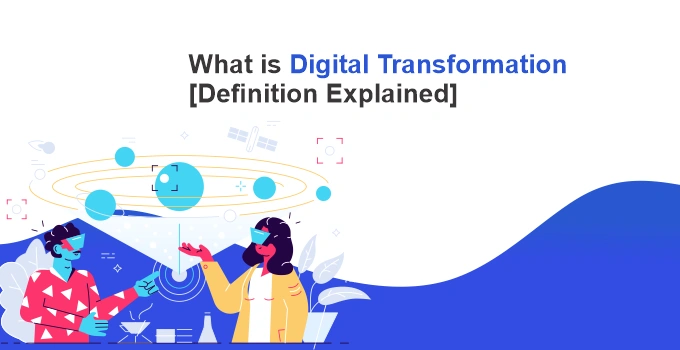What Is Digital Transformation? [Definition Explained]
- What is Digital Transformation?
- The Process of Digital Transformation
- 1.Starting with a Purpose
- 2.Determine the Scale of Project
- 3.Carefully Consider Enabling Technology
- 4.Focus on the Shift in the Culture
- 5.Optimizing the Customer Experience
- Advantages of Digital Transformation
- Do You Have a Digital Marketing Strategy?
We have heard the term “digital transformation” quite often, but what does it mean? This concept is a hot topic that comes and goes with every technology cycle. Even before digitization became a familiar term to most consumers – and long before the concept of ubiquitous connectivity became a reality – traditional businesses have been transforming their operations through technology.
What is Digital Transformation?
Digital transformation has been a popular subject in the media of late, and the growth in direct digital transformation technology investment is likely to level off by 2023. The popular digital transformation is a subject of strong interest to people. The total amount of money that will be invested in digital transformation technologies between 2020 and 2023 is $6.8 trillion.
All entrepreneurs think that their business will be the next digital sensation. You have to consider whether the digital business world is a good fit for your strengths and passions. The term ‘digital transformation has become so widespread that no one seems to agree on what it means—but that doesn’t mean you should stop using it.
Some say that it’s primarily about how technical solutions fit together. Some say that it changes the entire business from the inside out. The process of business transformation is a dynamic journey and both definitions fit on this. But let’s look at exactly what a business transformation strategy is and how it should be applied.
The Process of Digital Transformation
These are three criteria you can use to judge your company’s readiness for digital transformation.
- The business culture
- The technology
- The people
Transformation requires a combination of these things. What is the process of digital transformation? There are some steps to consider:
- Starting with a purpose
- Determine the scale of the project
- Carefully consider enabling technology
- Focus on the shift in the culture
- Optimizing the customer experience
1.Starting with a Purpose
Less time you spend on distractions, the more time you’ll have to devote to whatever matters most to you. The purpose is crucial when getting started with a new process or task. Understanding the rationale behind current processes will help you build enthusiasm and buy-in.
The more clearly you define what you want to achieve with your Blockchain initiative, the faster you will be able to produce results.
Click here to read: An introduction to Blockchain Technology
2.Determine the Scale of Project
In many organizations, there are big differences between departments or teams in their capacity for innovation and digital operations. Maybe you are not as ready as others to deal with the future. Maybe, though, your competitors are only now beginning to adapt their businesses to changing conditions.
Either way, the first step (whether you’re building a product or a service) is to figure out what stage in the development/life cycle your idea is in. To create a model, you first have to determine what stage your organization is in and then adjust your processes according to how far through the stages they are.
Click here to read: Are Project Management Skills Key to the Success of Software Development?
3.Carefully Consider Enabling Technology
You should choose the right enablers depending on the state of your transformation and your purpose. When it comes to transformation, most people only see the technology approach. In reality, the tech-first approach is only one reason for failure. If you’re going to focus on enterprise technology solutions, then your focus should be on these elements.
- The central idea behind the transformation effort
- What stage of transformation do you want to reach?
- What kinds of new systems and procedures are your competitors starting to implement that you should be thinking about?
4.Focus on the Shift in the Culture
When you’re trying to implement new technology, it’s just as important to make sure the entire business culture supports it. Cultural change must be made to successfully streamline the business process. Employees need to understand the tax implications of their decisions, and they need to be given access to the information that they need.
Poor alignment can cause failures in the last stage of a process. People working on such an operation will be reluctant to devote too much energy to it. To succeed in implementing digital transformation technology, everyone involved has to be on the same page.
Click here to read: IT Project Management: Everything you should know!
5.Optimizing the Customer Experience
It’s important to remember that you should focus on both efficiency and effectiveness when it comes to transformation efforts. Breaking down the data silos of your business can dramatically improve the customer experience. Getting high-quality consumer insight is hard, but it’s worth it when you can tap into that information to continuously improve. This works best if you’re using the combined knowledge.
Advantages of Digital Transformation
Following are the advantages of the digital transformation:
- Better customer retention
- Increased sales opportunities
- Enhanced customer experience
- Innovation and creativity
- Brand Reputation And Contribution
- Creates opportunities in new markets
Do You Have a Digital Marketing Strategy?
With so many companies struggling to adapt to the changing business environment, a successful switch to digital is essentially a matter of survival. The combination of the right tools and a person’s ability to use those tools to its advantage is what draws a company closer to its digital goals.
If you are wondering how to leverage technology and innovation to change your business, contact a digital transformation expert today.
Click here to read: Top 10 Factors To Select The Best Professional IT Services!



